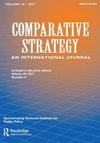不对称冲突结果模型——对摩擦的敏感性和反叛乱战略的选择
Q3 Social Sciences
引用次数: 0
摘要
摘要本文评估了一个基于反叛乱分子暴露于外部摩擦和策略的预测反叛乱结果的模型。不利的意见,以及叛乱分子获得第三方支持和庇护,构成了外部摩擦的根源。战略主要分为动态战略或以人口为中心战略。该模型预测:(1)无论策略如何,反叛乱分子都会在外部摩擦高的情况下失败;(2) 如果外部摩擦很低,采用以人口为中心战略的反叛乱分子就会获胜;(3) 如果只有通过获得明显的战术优势,外部摩擦很低,那么采用纯粹动能战略的反叛乱分子就会获胜。该模型正确预测了30例检查病例中的27例。本文章由计算机程序翻译,如有差异,请以英文原文为准。
A model of asymmetric conflict outcome – Sensitivity to friction and choice of strategy in counterinsurgencies
Abstract The article assesses a model predicting outcome in counterinsurgencies based on the counterinsurgent’s exposure to external friction and strategy. Unfavorable opinions, as well as insurgents’ access to third-party support and sanctuaries, constitute sources of external friction. Strategies were categorized as mainly kinetic or population-centric. The model predicts: (1) counterinsurgents lose in contexts with high external friction regardless of strategy; (2) counterinsurgents applying a population-centric strategy win if external friction is low; (3) counterinsurgents applying a purely kinetic strategy win if external friction is low only by obtaining distinct tactical superiority. The model correctly predicted 27 of 30 examined cases.
求助全文
通过发布文献求助,成功后即可免费获取论文全文。
去求助
来源期刊

Comparative Strategy
Social Sciences-Political Science and International Relations
CiteScore
0.90
自引率
0.00%
发文量
41
 求助内容:
求助内容: 应助结果提醒方式:
应助结果提醒方式:


